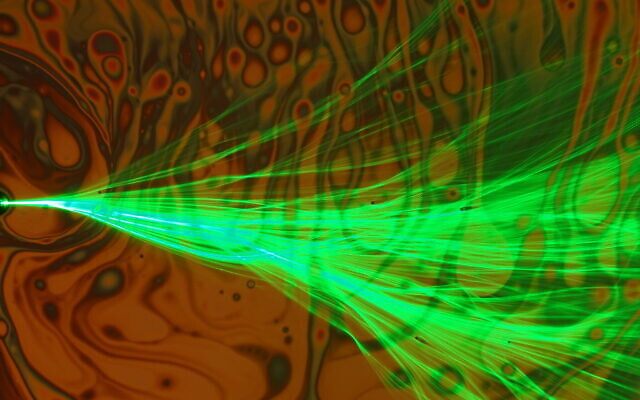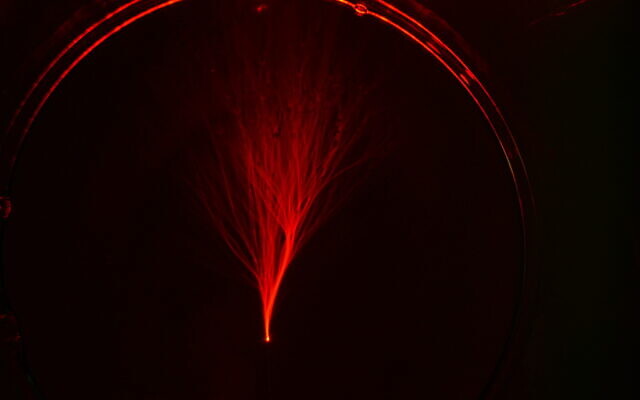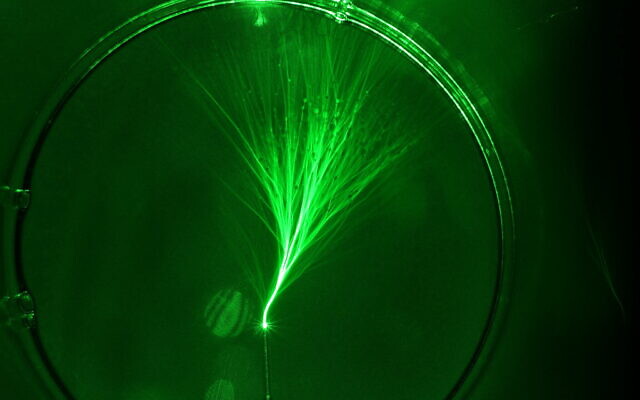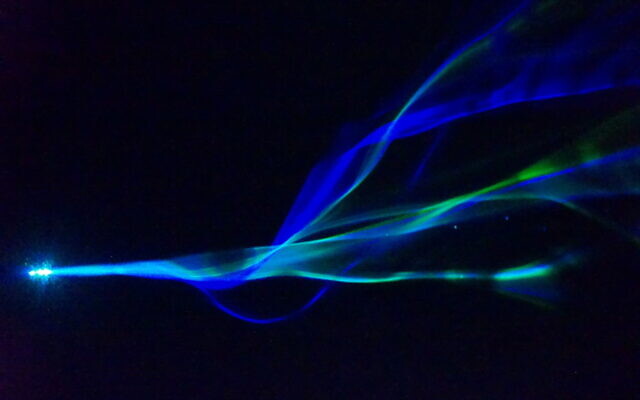www.timesofisrael.com/blowing-bubbles-israeli-physicists-accidentally-make-breakthrough-on-light/
Technion researchers demonstrate branched flow, a ‘beautiful’ process that scientists have written about for years, but never seen

Branched flow, with bubbles in the background, as observed through a microscope at the Technion - Israel Institute of Technology (courtesy of the Technion - Israel Institute of Technology)

Branched flow, as observed through a microscope at the Technion - Israel Institute of Technology (courtesy of the Technion - Israel Institute of Technology)
In an accidental breakthrough made while blowing kids’ soap bubbles, Israeli scientists have observed light behaving in a “beautiful” manner never before seen by the human eye.
They captured the process on camera and wrote an academic paper declaring themselves the first people to see a physical phenomenon called “branched flow” in action, which will be the cover story in Thursday’s edition of the renowned journal Nature.
“There is nothing more exciting than discovering something new, and this is the first demonstration of this phenomenon with light waves,” said Uri Sivan, president of the Technion – Israel Institute of Technology. Anatoly Patsyk, a PhD student involved in the discovery, called it “another one of nature’s surprises.”
Technion physics professor Moti Segev told The Times of Israel that he had no idea, at first, what he was looking at.
“We were shining light into bubbles, and started to notice a very pretty and peculiar scattering process, in which the light splits into branches, like branches of a tree,” he said.
They had no idea why this was happening.

Branched flow, as observed through a
microscope at the Technion – Israel Institute of Technology (courtesy of
the Technion – Israel Institute of Technology)
This process was discovered in 2001, but the closest scientists got to witnessing it was through an electron microscope, which doesn’t provide an actual view of the target being examined, but rather uses electrons to probe the target and construct an image of what is happening. Only limited scientific exploration is possible from this image.

Soap bubbles used by the scientists in
order to see branched flow, illuminated with white light, as observed in
the microscope (courtesy of the Technion – Israel Institute of
Technology)
“The important moment was when we understood what we had in front of us,” he commented. “Before that, it was the beautiful outcome of an experiment, but then it became meaningful in scientific terms.”

Branched flow, as observed through a
microscope at the Technion – Israel Institute of Technology (courtesy of
the Technion – Israel Institute of Technology)
He said that it will lead to a new area of physics, and believes that the light from branched flow will be useful in medical diagnosis, as he thinks it could bring about more pinpointed examination of blood vessels and veins, and could also be developed to “steer the flow of liquid” inside the body to remedy some health issues.
Segev said that the surprising thing about the breakthrough is how easy it was to observe branched flow. His team was shining light, through an optical fiber, into the membrane of a bubble, meaning directly into the soapy substance that forms the bubble and not into the air inside the bubble.
“Had anybody inserted a light into the wall of a soap bubble before now, they would have seen it but no one had reason to do so,” he commented.

Soap bubbles used by the scientists in
order to see branched flow, illuminated with white light, as observed in
the microscope (courtesy of the Technion – Israel Institute of
Technology)
He said that people wouldn’t be able to see branched flow at home, as they would need a way to hold a bubble still without bursting it and a fiber-optic light, but said that science enthusiasts, with some lab equipment could do so easily.
“In principle we could teach a high school student to do it,” he commented.

No comments:
Post a Comment